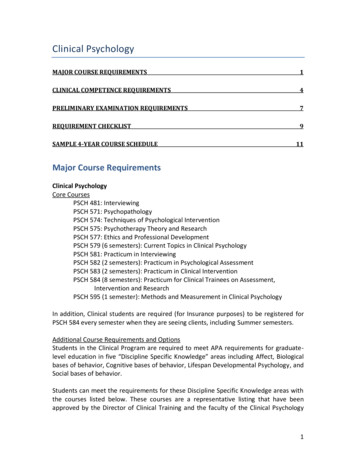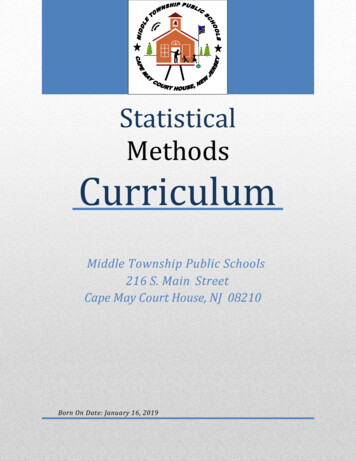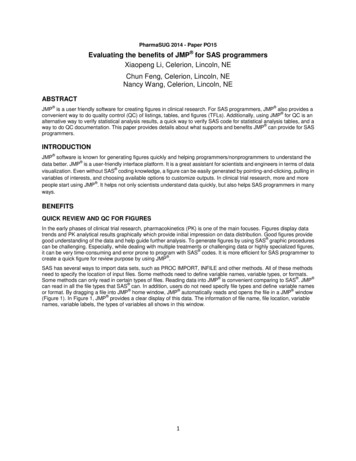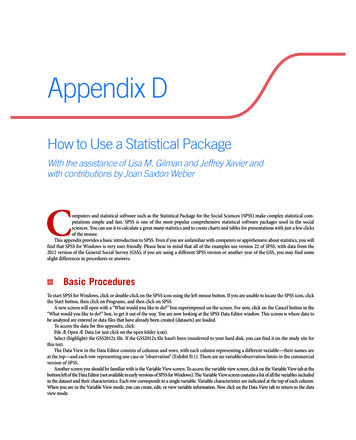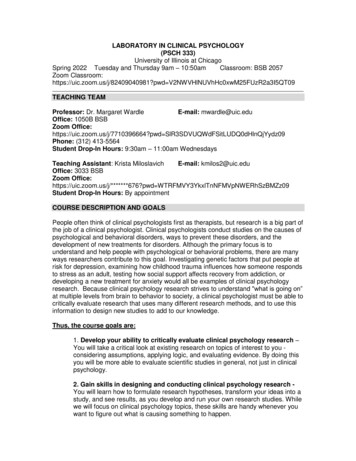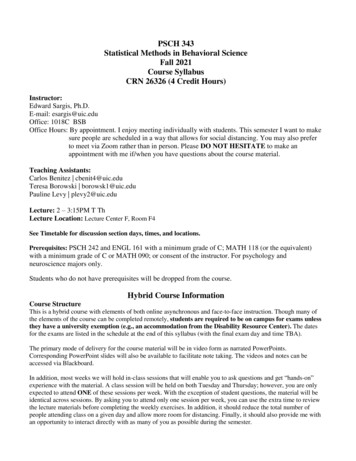
Transcription
PSCH 343Statistical Methods in Behavioral ScienceFall 2021Course SyllabusCRN 26326 (4 Credit Hours)Instructor:Edward Sargis, Ph.D.E-mail: esargis@uic.eduOffice: 1018C BSBOffice Hours: By appointment. I enjoy meeting individually with students. This semester I want to makesure people are scheduled in a way that allows for social distancing. You may also preferto meet via Zoom rather than in person. Please DO NOT HESITATE to make anappointment with me if/when you have questions about the course material.Teaching Assistants:Carlos Benitez cbenit4@uic.eduTeresa Borowski borowsk1@uic.eduPauline Levy plevy2@uic.eduLecture: 2 – 3:15PM T ThLecture Location: Lecture Center F, Room F4See Timetable for discussion section days, times, and locations.Prerequisites: PSCH 242 and ENGL 161 with a minimum grade of C; MATH 118 (or the equivalent)with a minimum grade of C or MATH 090; or consent of the instructor. For psychology andneuroscience majors only.Students who do not have prerequisites will be dropped from the course.Hybrid Course InformationCourse StructureThis is a hybrid course with elements of both online asynchronous and face-to-face instruction. Though many ofthe elements of the course can be completed remotely, students are required to be on campus for exams unlessthey have a university exemption (e.g., an accommodation from the Disability Resource Center). The datesfor the exams are listed in the schedule at the end of this syllabus (with the final exam day and time TBA).The primary mode of delivery for the course material will be in video form as narrated PowerPoints.Corresponding PowerPoint slides will also be available to facilitate note taking. The videos and notes can beaccessed via Blackboard.In addition, most weeks we will hold in-class sessions that will enable you to ask questions and get “hands-on”experience with the material. A class session will be held on both Tuesday and Thursday; however, you are onlyexpected to attend ONE of these sessions per week. With the exception of student questions, the material will beidentical across sessions. By asking you to attend only one session per week, you can use the extra time to reviewthe lecture materials before completing the weekly exercises. In addition, it should reduce the total number ofpeople attending class on a given day and allow more room for distancing. Finally, it should also provide me withan opportunity to interact directly with as many of you as possible during the semester.
During weekly discussion sections, your TA will hold open sessions in which you can work on an assignedproblem for the week. The problems will be based on the week’s lecture material.Attendance PolicyAttendance at class lecture meetings and discussion sections is strongly encouraged but not required. You arerequired to turn in any exercise we work on during class time, but there are no points tied specifically to attendinglecture and discussion. However, unless you have an exemption from the university (e.g., via the DisabilityResource Center), you are required to take examinations in the class in person. There are some students who maynot be vaccinated due to a religious or health exemption. We will follow university protocol for sitting for anexam (excerpt from: n-Campus Exams: If you are a student who is not coming to campus to attend classes, you will berequired to adhere to the campus COVID-19 testing requirements and have a saliva test prior to coming tocampus to take the exam. Saliva testing must be completed at UIC not earlier than 48 hours and not morethan 72 hours ahead of the exam date, so that the test result is available (and negative) by the date of theexamination. You must be prepared to present your UIC Daily Pass at the examination site. Note that theSaliva Testing Badge AND the Healthcheck Badge must be “green” to sit for the examination. A processfor validation of these badges prior to in-person exams is under development and will be communicatedvia an email announcement through our Blackboard course site as well as an announcement during class.All students are responsible for monitoring the Blackboard course announcements to ensure suchmessages do not get missed.Masking: For students attending class, face masks are required. Masks covering both the mouth and nose must beworn at all times by all students, faculty, and staff while on campus and inside any building regardless ofvaccination status. If you do not wear a mask, you will be asked to leave the classroom and will not be allowedback in class unless or until you wear a mask. If you have forgotten your mask, you may pick one up from one ofthe student information desks on campus during the first two weeks of campus. Students who do not comply withthe mask wearing policy will be reported to the Dean of Students. Eating and drinking is not allowed inclassrooms.Course CommunicationBlackboard will serve as the communication hub for the course. Each week I will send an email via Blackboardwith information about the week’s activities. The information in these emails can also be found in the “WeeklyContent” area of Blackboard for the corresponding week. In the weekly message, I will indicate and provide linksto the lectures you are responsible for viewing that week. I will also remind you of any activities and assignmentsdue for the week (more information below). Finally, I will include any special announcements. It is yourresponsibility to read these weekly messages to stay informed about the course material.Technology RequirementsFor the most part, the technology needs of the course are basic. Coursework can be completed on a basic laptop ortablet with an internet connection. For turning in assignments with written work, you may also choose to use asmartphone with a camera to scan your work.Required Course Material:A basic pocket calculator. You should bring this calculator with you to lecture and lab sections. Any basiccalculator will do as long as it can perform addition, subtraction, multiplication, and division, as well as computesquare roots. Note that you will not be allowed to use cell phone or graphing calculators on exams. If you arefound using one during an exam, you may receive a zero on that exam.
General Course OverviewOverviewThis is an introductory course in statistics that is designed for students majoring in Psychology and Neuroscience.The primary goal of the course is to develop your understanding of the ways in which mathematics and statisticsare used to deepen our understanding of psychological phenomena. To accomplish this goal, we will work todevelop your conceptual understanding of statistics. People often believe that learning statistics entailsperforming rigorous hand calculations. However, that is not the focus of this course. This is not to say that youwill not perform calculations by hand. Rather, this course is designed to help you understand what the termswithin various formulae mean, how various statistics are calculated, and how to interpret the results of statisticalanalyses. More important than calculating the correct numerical answer to a statistics problem is yourunderstanding of what that number means, both in general terms and with respect to the research question you areattempting to address. We will also work to strengthen your confidence in your ability to understand statistics inpublished articles (both research articles as well as those you encounter in newspapers, on television, etc.), and inyour ability to determine the kinds of statistical analyses that are appropriate for different kinds of data andresearch questions.Course Learning ObjectivesWe will learn several statistical techniques over the course of the semester. For each statistical technique, you willlearn: what the statistic can tell us about our data. the conceptual foundations of the statistics (i.e., how does it capture the characteristic of the data we areinterested in?). how the statistic is computed. what a calculated statistic tells us about our data (i.e., how do we interpret the statistic we calculated?). what the statistic implies about the research question we are trying to answer (i.e., what are the largerimplications of the statistic for the research?).After taking this course, you will be able to: differentiate the different statistics we will discuss. select the appropriate statistical analysis to best evaluate a research question. interpret the results of basic statistical analyses.Finally, you will develop foundational knowledge that will prepare you to learn more advanced statisticaltechniques used in the field.Suggested TextI do not require a text for this course. In the distant past I used to require “Statistics for the Behavioral and SocialSciences” by Aron and Aron (now Aron, Coups, and Aron). However, I found that I do not fully utilize it and Itherefore do not require students to purchase the text. With that said, if you would like a book that will reinforcethe concepts we will talk about, I recommend the Aron, Coups, and Aron book. There are many editions of thetext. I think that any edition of that text would work. There are other statistics books out there, many of them aregood, however other books might cover the material differently than I (or Aron, Coups, and Aron) cover it, sothey could cause more confusion than they alleviate. With all this said, the vast majority of students do fine in thecourse without a book.Course AssessmentsWeekly Application/Interpretation ExercisesMost weeks we will complete an in-class exercise (during the lecture meetings) that will provide us with practiceapplying the concepts covered in the lecture videos. The focus of these exercises will be on interpreting variousstatistics or on demonstrating a statistical concept using data we collect or generate. A portion of each class will
be devoted to working on these exercises. As noted above, there will be one exercise posted in each week.Though you are welcome to show up to both lecture meetings in a week, the exercise will be the same for bothTuesday and Thursday. Therefore, the vast majority of you will only want to attend one session per week. Again,the purpose here is to split the class up into more manageable groups so that I can answer your questions, interactwith more of you directly, as well as free up some of your time to view the week’s videos.The materials for these exercises will be posted on Blackboard by class time on Tuesday of each week they aredue and will be due via Blackboard by 7pm on Thursday of the week they are assigned. My goal when creatingthese assignments will be to have it be something that can be completed within a typical class period (i.e., youshouldn’t have to work on them outside of class time). The most important thing you will need to do to prepare isto have reviewed the relevant lecture materials BEFORE completing the exercises. These exercises are not examsand so you may refer to your notes as you complete them, however you will be better able to complete them ifyou are familiar with the material before you attempt it. Finally, you are not required to come to class to completethese assignments, but you are strongly encouraged to attend. During class time we will go through the exercisestogether and you will have an opportunity to discuss and refine your answers. The Application/Interpretationexercises will be graded pass/fail based on completion and the accuracy of your responses. You are also allowedto miss one Application/Interpretation exercise without penalty.Discussion Section ExercisesEach week, unless otherwise noted in the syllabus or in the weekly announcement, you will complete an activitythat will give you experience computing the various statistics we will cover during the semester. These activitieswill be made available on Thursdays and need to be completed by midnight Friday the week they are posted. Theexercises will be graded pass/fail based on whether you completed the full activity or not (i.e., no partial credit).You may miss one Discussion Section Exercise without penalty.You will submit a copy of your discussion section exercises via Blackboard. The submission link for each weekcan be found in the corresponding folder for the week in the “Weekly Content” area of Blackboard.HomeworkA total of 7 homework assignment will be offered over the course of the semester. Homework will be due on thedates outlined in the syllabus. Your lowest of the seven homework grades will be dropped.Keep two things in mind when doing the homework:1. Be sure to show all your work for each problem that requires written calculations. Do not simply report yourfinal answer. If your final answer is incorrect it may still be possible to earn partial credit if some parts of theproblem were done correctly. This is possible, however, only if you have shown all of your intermediatesteps.2. Neatness counts. If your work is illegible, crammed together, or so disorganized that it cannot be followedstep by step in a logical sequence it will be difficult to assign partial credit.Late Policy for AssignmentsIt is your responsibility to turn in your work on time. However, I also know that sometimes problems come upthat prevent you from turning in an assignment by the deadline. We will make a one-time exception to turn in anassignment up to 48 hours late. Beyond this, anything late or missing cannot be made up for credit. Note: Allreferences to time are Central Time. Assignments are due by the end of day (i.e., 11:59PM CDT) on the day of theweek they are due.Student Collaboration and Academic IntegrityI do not mind if students work together, in parallel, on application/interpretation exercises, homeworkassignments, or discussion activities. Appropriate examples of collaboration include working together on adiscussion section assignment or consulting another student on how to do a homework problem. On these types ofassignments, you should always do your own work, but it would be permissible to check your answer with afellow student or ask a question. If there was a discrepancy in an answer, both students should check their work
and discuss where something might have gone wrong with a computation or interpretation of a result. Under nocircumstances should one student simply give an answer to another student to copy. Should this happenBOTH STUDENTS would fail the course (see below for more information on student disciplinary procedures).ExamsThere will be four exams offered during the course: three exams during the semester and a final exam. Yourlowest grade of the four will be dropped. The exams will be worth 60% of your final grade (See below for examdates). Exams offered during the semester will be non-cumulative with the caveat that each section of the coursebuilds on previous sections. Though I will not explicitly test you on concepts from an earlier unit, you will haveto draw on knowledge from previous units on later exams. A cumulative final exam will be offered during theweek of finals.As mentioned above, the lowest of the four exams will be dropped. The primary reason one exam will be droppedis that it eliminates the need for make-up exams. Make-up exams will be given under only under extremelylimited circumstances. The only exceptions are where university policy has precedent over my syllabuspolicy (e.g., religious holidays, military service, disability accommodations). Any make-up exam will be adifferent length and format than that administered during the regular exam window.It should go without saying that you should complete exams entirely on your own, without assistance from othersor an unapproved aid (i.e., a cheat sheet). Students found cheating on an exam, whether by providing orreceiving answers from another, or by using another, unapproved resources will immediately fail thecourse. See below for additional information on student disciplinary procedures.Course GradingCourse grades will be based on Application/Interpretation Exercises (10%), Discussion SectionActivities (10%) Homework (20%) and Exams (60%). Grades will be based on the following scale:GradePercentABCDE89.5 – 10079.5 – 89.469.5 – 79.459.5 – 69.40 – 59.4To estimate your grade during the semester, you can use the following formula:(0.10 * Weekly Progress Assessment Completion %) (0.10 * Discussion Section Activity Completion %) (0.20 * Homework Average) (0.60 * Exam Average)Additional NotesAcademic IntegrityI designed this course to be as flexible as possible and I believe getting a good grade in the class is veryachievable. The drop policy typically helps students who might underperform on an exam or homeworkassignment. Additionally, several components of the course (e.g., Discussion Section Activities) includepoints that are guaranteed as long as you complete the work. I want you to be successful in the course and Ibelieve that you will be successful if you put in the work. In fairness to those students who are workinghard to get the course material, any student found to be cheating in the class, no matter how minor of anoffense, will likely fail the course. This includes anyone providing answers to another student. In all cases Iwill file a complaint against you with the Dean of Students, who will place a notice about the incident in yourstudent file. There will be no exceptions to this policy.
Cheating includes but is not limited to copying or giving others test answers, or copying another students work ona homework assignment. Note that cheating often involves at least two students. To be clear, any student who is aparty to academic dishonesty will be subject to the penalties outlined above.Please see the following for additional information about academic dishonesty and student ent/uploads/sites/262/2020/01/DOS Student-Disciplinary-Policy-2020.pdfEmailsI do my best to respond to student emails in a timely manner. I read every email I receive, but sometimes I amunable to respond to students as quickly as I would like. If I do not respond to an email question within 48 hours,please resend me your email. In emails, always identify yourself and what class you are in.It will be your responsibility to keep track of your scores in Blackboard. If you notice that a score has beenincorrectly entered into Blackboard, you must show the original work with the correct grade to your TA byMonday of finals week.Disability AccommodationsThe University of Illinois at Chicago is committed to maintaining a barrier-free environment so that students withdisabilities can fully access programs, courses, services, and activities at UIC. Students with disabilities whorequire accommodations for access to and/or participation in this course are welcome, but must be registered withthe Disability Resource Center (DRC). You may contact DRC at 312-413-2183 (v) or 773-649-4535 (VP/Relay)and consult the ns.Religious Holidays: Students who wish to observe their religious holidays must notify me by the tenth day of thesemester they will be absent unless their religious holiday is observed on or before the tenth day. In such cases,the student shall notify me at least five days in advance of the date when he or she will be absent.Incomplete Grades: University policy on incomplete grades is very strict and I follow that policy. I will grant anincomplete grade only under the most extreme circumstances. Do not request an incomplete unless the followingconditions apply (taken from the undergraduate catalogue):Course work is incomplete when a student fails to submit all required assignments or is absent from the finalexamination; incomplete course work will normally result in a failing grade. The IN (incomplete) grade may beassigned in lieu of a grade only when all the following conditions are met: (a) the student has been makingsatisfactory progress in the course; (b) the student is unable to complete all course work due to unusualcircumstances that are beyond personal control and are acceptable to the instructor; (c) the student presents thesereasons prior to the time that the final grade roster is due. The instructor must submit an Incomplete report with thefinal grade roster for the IN to be recorded. This report is a contract for the student to complete the course workwith that instructor or one designated by the department executive officer in the way described and by the timeindicated on the report. In resolving the IN, the student may not register for the course a second time, but mustfollow the procedures detailed on the report. An IN must be removed by the end of the student’s first semester orsummer session in residence subsequent to the occurrence, or, if not in residence, no later than one calendar yearafter the occurrence. When the student submits the work, the instructor will grade it and change the IN to theappropriate grade. If an undergraduate fails to meet the stated conditions, the instructor will assign an E for the finalgrade.Note that you will be graded according to the grading criteria listed above. Please do not ask to be bumped upto the next highest grade at the end of the semester (e.g., ask me for a C in the course when you have a 67.7%in the course). I will not do this. The number one factor that puts students in this situation is missed assignmentsand quizzes. I am unable to make exceptions for one student that I am not able to make for others in the class.With this said, if you have any problems or concerns throughout the class, please come see us during ouroffice hours, before it is too late at the end of the semester. I and the TAs are happy to work with you during
the semester to help facilitate your understanding of the course material. Please use office hours wheneverpossible, but we are willing to make appointments if your schedule makes it impossible to make our office hours.Tentative course topics scheduleThe following page contains a listing of topics. I fully intend to stick with this schedule, but it is your responsibility to keeptrack of any changes that might occur throughout the semester. Note: The dates listed correspond to the Monday of eachweek.Date WeekWeek #Lecture TopicBeginsIntroductionQuantification and Scales of Measurement8/231No Application/Interpretation Exercise Week 1No Discussion Section Exercise Week 1Graphic Display of Data8/30Central tendency2No Application/Interpretation Exercise Week 2Variability9/6Z-Scores3Homework 1 Due Friday, September 10Quantifying the Association Between Variables: Covariance Quantifying the9/13Association Between Variables: Correlation4Homework 2 Due Friday, September 17Catch-up/ReviewEXAM 1 – Thursday, September 239/205Homework 3 Due Friday, September 24No Application/Interpretation Exercise Week 5No Discussion Section Exercise Week 569/27Introduction to Statistical ModelingEstimating parameters of simple linear models710/4Evaluating model fit: R-squaredEvaluating Model Fit: Comparing Mathematical 2Explaining Residual Variance: Errors in models and errors in measurement precisionSampling error: An intuitive exploration of the problemHomework 4 Due Friday, October 15Catch/up ReviewEXAM 2 – Thursday, October 21No Application/Interpretation Exercise Week 1No Discussion Section Exercise Week 9Quantifying sampling error: The standard error of the meanNull hypothesis significance testing: Using sampling distributions to make decisionsabout sampling errorNull hypothesis significance tests: One Sample and Dependent Means t-testsNull hypothesis significance tests: Independent Means t-tests (cont.)Null hypothesis significance tests: ANOVAHomework 5 Due Friday November 12A Conceptual Introduction to Factorial ANOVANull hypothesis significance tests: Chi-SquareHomework 6 Friday November 19Statistical power & effect sizeHomework 7 Due Wednesday, November 24No Application/Interpretation Exercise Week 14No Discussion Section Exercise Week 14
1511/29**EXAM 3 – Tuesday, November 30No Application/Interpretation Exercise Week 15No Discussion Section Exercise Week 15FinalExams---FINAL EXAM – Date TBA
Carlos Benitez cbenit4@uic.edu Teresa Borowski borowsk1@uic.edu Pauline Levy plevy2@uic.edu Lecture: 2 - 3:15PM T Th Lecture Location: Lecture Center F, Room F4 See Timetable for discussion section days, times, and locations. Prerequisites: PSCH 242 and ENGL 161 with a minimum grade of C; MATH 118 (or the equivalent)
